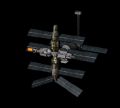Difference between revisions of "Mir"
Jump to navigation
Jump to search
(Added gallery images.) |
(Added image.) |
||
| Line 15: | Line 15: | ||
<gallery> | <gallery> | ||
MIR-orbiter2002p3.jpg|<center>Mir in Orbiter 2002P3</center> | MIR-orbiter2002p3.jpg|<center>Mir in Orbiter 2002P3</center> | ||
| + | Mir-Orbiter2003P2.jpg|<center>Mir in Orbiter 2003P2</center> | ||
Mir Space Station viewed from Endeavour during STS-89.jpg|<center>MIR as viewed by [[w:Space Shuttle Endeavor|Space Shuttle ''Endeavor'']] during STS-89 on 29 January 1998,<br>from Wikimedia Commons</center> | Mir Space Station viewed from Endeavour during STS-89.jpg|<center>MIR as viewed by [[w:Space Shuttle Endeavor|Space Shuttle ''Endeavor'']] during STS-89 on 29 January 1998,<br>from Wikimedia Commons</center> | ||
</gallery> | </gallery> | ||
Revision as of 12:01, 7 September 2024
In Orbiter, the Russian MIR station is still in orbit around Earth and can be used for docking approaches. Furthermore, unlike its real-life counterpart, Orbiter’s MIR is orbiting in the plane of the ecliptic, which makes it an ideal platform to launch lunar and interplanetary missions.
MIR sends a transponder (XPDR) signal at default frequency 132.10 which can be used for tracking the station during a rendezvous maneuver.
MIR supports 3 docking ports, with the following IDS transmitter frequencies:
- Port 1 135.00
- Port 2 135.10
- Port 3 135.20
Gallery
MIR as viewed by Space Shuttle Endeavor during STS-89 on 29 January 1998,
from Wikimedia Commons



